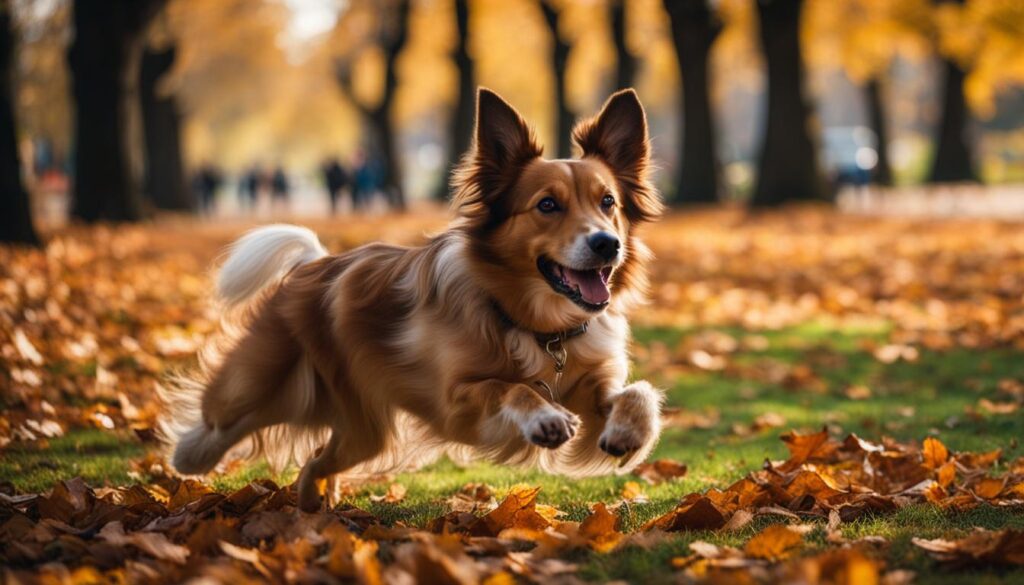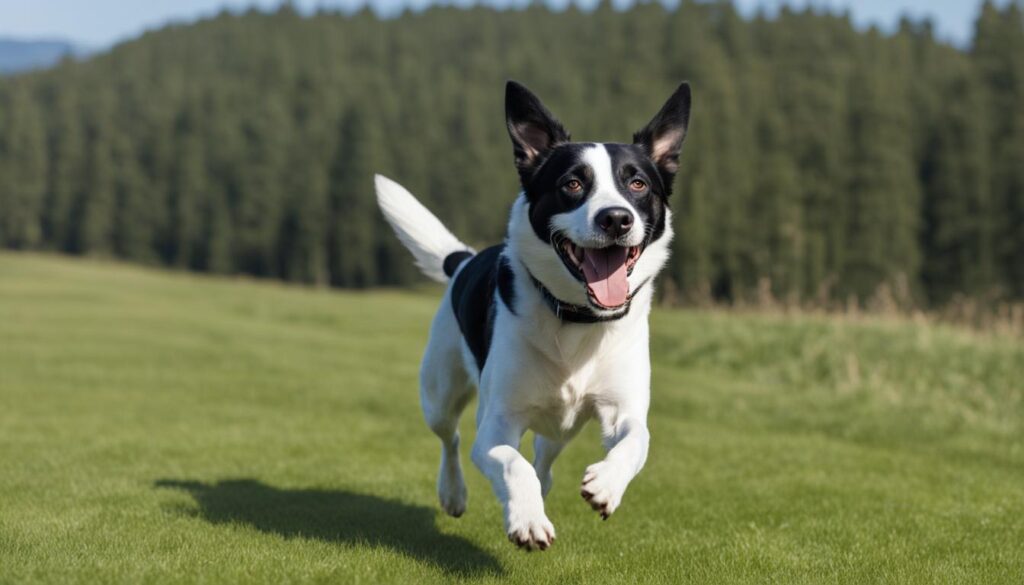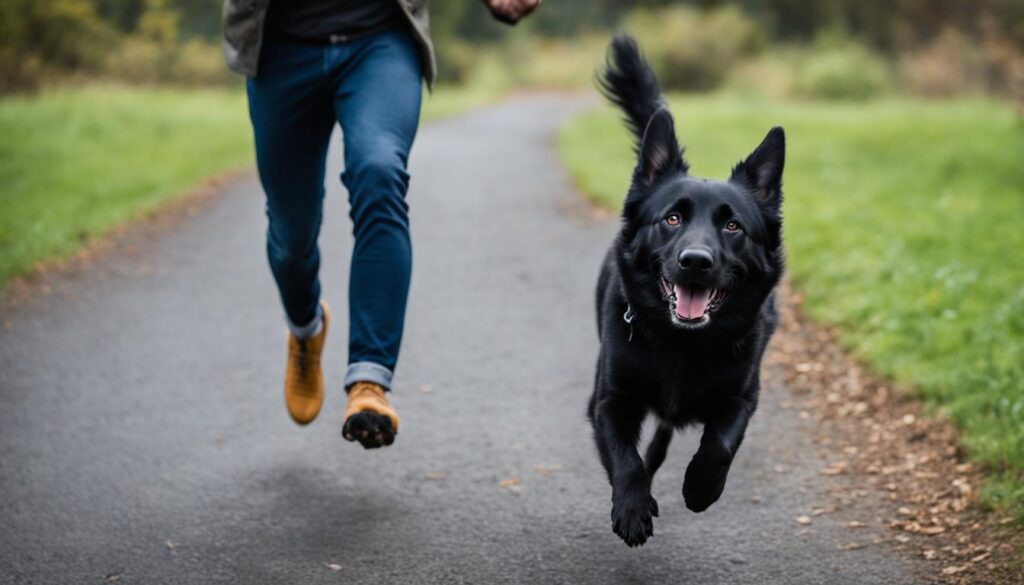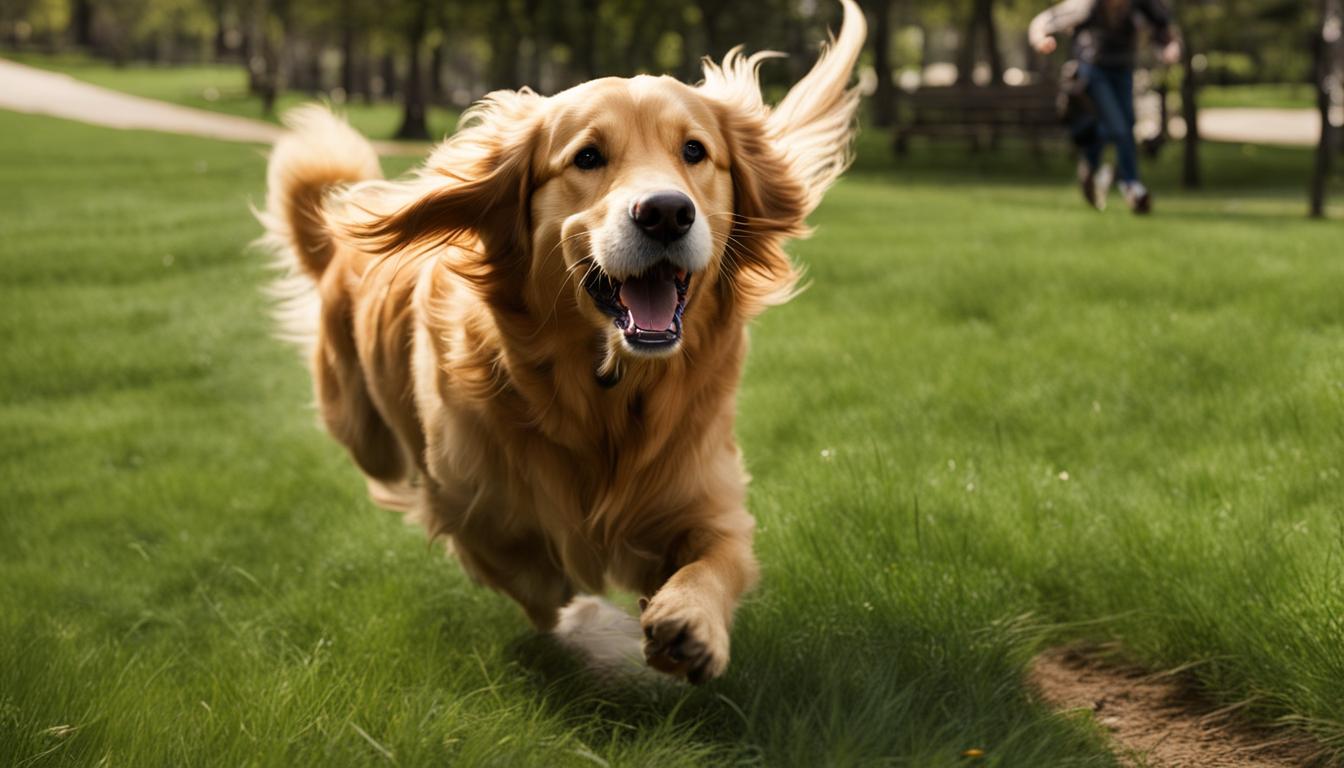If you’re a dog owner, you may have experienced the delightful, yet sometimes puzzling, behavior of your furry friend running into you at full speed. So, why does my dog run into me full speed? Let me break it down for you.
When dogs run into their owners at full speed, it's often a display of excitement and a desire for interaction. It's their way of saying, “Hey, I'm so happy to see you!” Dogs are known for their exuberant nature and this behavior is no exception. Running into you is their way of expressing their joy and love.
Understanding dog behavior is key to deciphering why they engage in certain actions. Dogs communicate through body language, and running into you is just one of their many forms of communication. By running into you, dogs are seeking physical contact and showing their affection towards you. It's their way of connecting with you and strengthening the bond between dog and human.
It's important to note that running into you at full speed is a natural behavior and not a cause for concern. However, it is crucial to ensure a safe environment to prevent any accidents or injuries. Redirecting this behavior outside or to a carpeted area can help minimize the risk.
Key Takeaways – Why Does My Dog Run Into Me Full Speed
- Dogs may run into their owners at full speed out of excitement and to initiate play.
- Running into you is a form of communication and affection from your dog.
- Ensure a safe environment to prevent injuries during these exuberant moments.
- Redirect the behavior to a suitable area, such as outside or a carpeted space.
- Running into you is a natural behavior and part of the special bond between dogs and their owners.
What are dog zoomies?
Dog zoomies, also known as Frenetic Random Activity Periods (FRAPs), are sudden bursts of energy where dogs run around in circles, chase their tails, and do laps around the house or garden. This behavior usually occurs when dogs have excess energy that needs to be released. It is most common in puppies and can be seen less frequently as dogs get older. Zoomies typically do not last very long and are followed by a period of rest.
Dogs are known for their energetic and playful nature, and zoomies are a perfect example of their exuberance. These bursts of energy can happen seemingly out of nowhere and often catch owners off guard. One moment your dog may be calm and relaxed, and the next they're tearing through the house at full speed, tail wagging and tongue flying.
During zoomies, dogs may exhibit a range of behaviors, such as running in circles, making quick turns, and engaging in playful antics. Some dogs may even jump on furniture or run laps around the yard. These energetic outbursts can be entertaining to watch and are generally harmless, as long as the environment is safe.
Zoomies are often a sign that dogs need to release pent-up energy. It's common for dogs to have bursts of energy after periods of rest, such as waking up in the morning or after a nap. Additionally, zoomies can be triggered by exciting events, such as a visit from a friend or the anticipation of playtime.
While zoomies are most commonly associated with puppies, adult dogs can also experience these frenetic bursts of energy. However, as dogs mature, they tend to have fewer zoomies and may exhibit a more controlled and focused play style.
Causes of Dog Zoomies
Dog zoomies, also known as Frenetic Random Activity Periods (FRAPs), are a natural behavior seen in dogs. It occurs when dogs have a build-up of excess energy that is then released in one short burst. These bursts of energy can be triggered by various factors, including:
- The need to blow off steam before bed
- An adrenaline rush after a bath
- Being food-oriented after eating
- A build-up of nervous energy during a training session
These triggers can vary from dog to dog and may be influenced by their daily routine and individual preferences. Understanding the underlying causes of dog zoomies can help dog owners better manage and channel their pet's energy in a positive way.


Safety concerns with dog zoomies
While the behavior of dog zoomies itself is not harmful, there are potential dangers associated with it. Dogs running at high speeds can skid on slippery floors or collide with furniture, leading to injuries. It's essential to prioritize safety when your dog is in zoomie mode to prevent accidents and ensure a positive dog-human interaction.
To mitigate the risks and keep your dog safe during zoomies, follow these tips:
- Provide a safe environment: Before your dog starts zooming, ensure the area is clear of any obstacles or fragile items that can be knocked over. Remove loose rugs or slippery surfaces that could cause your dog to slip and fall.
- Redirect to a suitable space: If your dog tends to zoom indoors, redirect their behavior to a more appropriate area, such as a fenced yard or a carpeted room. This helps minimize the chances of them running into furniture or skidding on slippery floors.
- Supervise outdoor zoomies: When your dog zooms outside, it's important to keep an eye on them to ensure their safety. Make sure the yard is secure and free from hazards, such as sharp objects or toxic plants.
- Regular exercise: Providing your dog with regular exercise can help reduce the frequency of zoomies. A tired dog is less likely to engage in high-speed bursts of energy indoors.
- Training and recall: Teaching your dog basic commands, such as “stop” or “come,” can help you regain control if their zoomies become unsafe. A reliable recall can help prevent them from running into potentially dangerous situations.
By prioritizing safety and taking preventive measures, you can ensure a fun and injury-free experience during your dog's zoomies.
Expert Tip:
“Redirecting your dog's zoomies to a designated area can not only keep them safe but also reinforce positive behavior. By providing a safe outlet for their excess energy, you can help prevent injuries and promote a stronger bond between you and your furry friend.”
– Dr. Amanda Rodriguez, Canine Behavior Specialist
Why dogs run into their owners
Dogs running into their owners at full speed can be a puzzling behavior to witness. However, there are several reasons why dogs exhibit this behavior, and it's important to understand their body language and behavior to interpret their actions.
Excitement and play
One reason why dogs run into their owners is out of excitement. They may be bursting with energy and view running into you as a playful gesture or a way to initiate a game. This behavior is often seen in younger dogs or those with high energy levels.
Communication and attention-seeking
Running into their owners can also be a form of communication for dogs. They may do it to get your attention or to convey a message. It could be their way of saying, “Hey, I'm here!” or “I want your focus and affection.” By running into you, they are seeking interaction and trying to establish a connection.
Poor eyesight and spatial awareness
In some cases, dogs may run into their owners unintentionally due to poor eyesight or a lack of spatial awareness. They might be unable to judge distances accurately or may have limited eyesight, causing them to accidentally collide with you. It's important to consider these factors when interpreting their behavior.


Interpreting your dog's behavior requires observation and understanding. By paying attention to their body language, tail wagging, ear position, and overall demeanor, you can gain insights into why they are running into you. Remember that every dog is unique, and their reasons for this behavior may vary.
Other Reasons Dogs Run into Their Owners
Besides excitement and communication, there are a few other reasons why dogs may run into their owners. Some dogs exhibit ADHD-like behavior, making them easily distractible and hyperactive. This can lead them to run into their owners without meaning to. Additionally, dogs with poor eyesight may unintentionally run into their owners while navigating their surroundings. Dogs that have a tendency to play rough and seek full-body contact may also run into their owners during playtime or moments of excitement.
To prevent dogs from running into their owners, it's important to provide proper exercise and mental stimulation. Regular physical activity helps to burn off excess energy, reducing the likelihood of zoomies or running into their owners out of hyperactivity.
Mental stimulation, such as puzzle toys or training sessions, can keep dogs engaged and focused, allowing them to channel their energy into more constructive behaviors. Training your dog in basic obedience commands like “sit,” “stay,” and “leave it” can also help reinforce boundaries and prevent them from running into you.
Avoid encouraging or reinforcing the behavior of running into you by redirecting your dog's attention to a toy or a designated play area. Provide clear and consistent cues and rewards to teach your dog appropriate ways to interact with you.
Remember, dogs typically engage in this behavior as a result of pent-up energy, instinctual play behavior, or sensory limitations. By addressing their physical and mental needs and implementing proper training techniques, you can promote positive dog-human interaction and mitigate the likelihood of dogs accidentally running into you.
“Training your dog in basic obedience commands like ‘sit,' ‘stay,' and ‘leave it' can help reinforce boundaries and prevent them from running into you.”
Frequently Asked Questions
Q: How can I prevent my dog from running into me during playtime?
A: To prevent your dog from running into you during playtime, ensure they have an adequate outlet for their energy before engaging in play. Take them for a walk or play a game of fetch to help them burn off excess energy. Additionally, teach them the “stay” or “wait” command, which will help them learn to stay in one place during play instead of running into you.
Q: My dog has poor eyesight and often runs into me unintentionally. What can I do?
A: If your dog has poor eyesight and frequently runs into you unintentionally, it's important to create a safe environment for them. Clear any obstacles that could pose a risk of injury, and provide them with consistent cues and commands to help them navigate their surroundings. You can also consult with a veterinarian for further guidance on managing their vision impairment.
Q: Is running into their owners a sign of aggression?
A: Running into their owners is typically not a sign of aggression in dogs. It is often a result of excitement, poor eyesight, or a desire for physical contact. However, if you are unsure about your dog's behavior or suspect aggression, it's best to consult with a professional dog trainer or behaviorist for an accurate assessment and guidance.
| Reasons Dogs Run into Owners | Description |
|---|---|
| ADHD-like behavior | Dogs with hyperactivity tendencies may run into their owners due to distractibility. |
| Poor eyesight | Dogs with vision impairment may unintentionally run into their owners while navigating their surroundings. |
| Desire for full-body contact | Some dogs may have a tendency to play rough and seek full-body contact, resulting in running into their owners. |
Why dogs bump into their owners
Dogs may bump into their owners for various reasons, and it's important to understand the underlying dog behavior and dog-human interaction. Bumping into owners can be a form of communication within the dog's social hierarchy.
Some dogs may bump into their owners to establish dominance and assert their role as the leader of the pack. It can be their way of demonstrating their position and superiority. On the other hand, some dogs may bump into their owners as a display of submission, seeking acceptance and reassurance.
Bumping into owners can also be a way for dogs to seek attention. By physically bumping into their owners, they are trying to grab their attention and elicit a response or interaction. Furthermore, dogs with herding instincts may bump into their owners as a way to herd them, guiding them in a certain direction or telling them it's time to move.
Understanding the context and body language of the dog is crucial in interpreting why they are bumping into you. Observing their overall behavior, including posture, tail position, and facial expressions, can provide valuable insight into their intentions and motivations.
Signs of dominance-seeking behavior:
- Dog consistently initiates contact by bumping into owner.
- Shows assertive body language, such as standing tall, erect posture, and direct eye contact.
- May exhibit other dominant behaviors, like growling or resource guarding.
Signs of submissive behavior:
- Dog bumps into owner gently, with a lowered head and tucked tail.
- Avoids direct eye contact and may lick the owner's face as a sign of appeasement.
- Tries to make themselves appear smaller in size by crouching or lying down.
Preventing excessive bumping:
“Effective communication and training can help redirect or modify the behavior.”
To address excessive bumping or when it becomes disruptive, redirection and training can be beneficial. Utilize positive reinforcement techniques to reinforce desired behaviors and discourage unwanted behaviors such as excessive bumping. Basic obedience training, such as teaching your dog the “sit” or “stay” commands, can help establish clear boundaries and manners.
It's important to note that if a dog's behavior becomes aggressive or poses a safety risk, consulting with a professional dog trainer or behaviorist is highly recommended. They can provide guidance and tailored solutions based on your specific situation and the dog's individual needs.


| Reasons dogs bump into their owners | Associated Behaviors |
|---|---|
| Establishing Dominance | Bumping into owners assertively, showing dominant body language |
| Seeking Attention | Bumping to elicit a response or interaction |
| Herding Instincts | Bumping into owners to guide and direct their movement |
| Submission and Acceptance | Gentle, appeasing bumping with submissive body language |
Reasons dogs walk into their owners
Sometimes, dogs may unintentionally walk into their owners due to distraction or a lack of spatial awareness. They may be focused on their surroundings or exploring their environment, causing them to walk into you. In other cases, dogs may walk into their owners for comfort or reassurance, seeking physical contact to feel secure.
“Dogs may seek physical contact with their owners by walking into them for comfort and security.”
Being aware of your dog's behavior and the environment can help prevent accidental collisions. Taking note of their body language and actions can give you insight into their intentions and allow you to adjust your movements accordingly.
Here are some common reasons why dogs walk into their owners:
- Distraction: Dogs may become engrossed in their surroundings or fixated on something else, causing them to accidentally walk into their owners.
- Eagerness for physical contact: Some dogs may walk into their owners as a way to seek comfort, reassurance, or physical contact. They may do this during stressful situations or when they are feeling anxious.
By understanding the reasons behind your dog's behavior, you can better interpret their actions and respond accordingly.
Reasons dogs walk into their owners
| Reason | Description |
|---|---|
| Distraction | Dogs may unintentionally walk into their owners when they are distracted by their surroundings or focused on something else. |
| Eagerness for physical contact | Some dogs may walk into their owners to seek physical contact, comfort, or reassurance. |
Why dogs run and jump on their owners
Dogs running and jumping on their owners is a common behavior that is often seen in puppies and young dogs. This behavior is a natural instinct for dogs to greet their caregiver and show excitement. However, it can be overwhelming and potentially dangerous, especially for larger dogs or those with exuberant energy. Understanding the reasons behind this behavior and implementing proper training techniques can help prevent dogs from jumping on their owners.
There are several factors that contribute to dogs running and jumping on their owners:
- Excitement: Dogs may jump up as a way to express their enthusiasm and greet their owners. They are excited to see you and want to get close, which often results in jumping.
- Pent-up energy: Dogs that have excess energy may engage in running and jumping behaviors as a way to release that built-up energy.
- Desire for interaction: Dogs are social animals and seek attention and interaction from their owners. Running and jumping on you may be their way of seeking physical contact and engagement.
To prevent dogs from running and jumping on their owners, it is important to provide them with proper training and redirection techniques:
- Teach basic obedience commands: Training your dog to follow basic commands such as “sit” or “stay” can help redirect their excitement towards more appropriate behaviors.
- Use positive reinforcement: Reward your dog for calm and controlled behavior. This will reinforce the desired behavior and encourage them to repeat it.
- Ignore jumping behaviors: Dogs may jump on their owners to seek attention. By ignoring this behavior and only giving attention when they are calm and on the ground, you can discourage jumping.
- Redirect their energy: Provide outlets for your dog's energy through regular exercise and mental stimulation. A tired dog is less likely to engage in excessive jumping behavior.
By implementing these training tips and techniques, you can encourage your dog to exhibit appropriate greetings and reduce jumping behaviors. Remember, consistency and patience are key when training your dog.
Training Techniques to Prevent Dogs from Jumping on Owners
| Technique | Description |
|---|---|
| Teach basic obedience commands | Train your dog to follow basic commands like “sit” or “stay” to redirect their excitement and energy. |
| Use positive reinforcement | Reward your dog for calm and controlled behavior to reinforce desired actions. |
| Ignore jumping behaviors | Withhold attention when your dog jumps, only rewarding and acknowledging them when they are calm and on the ground. |
| Redirect energy | Provide regular exercise and mental stimulation to tire out your dog, reducing their likelihood of engaging in excessive jumping. |
Implementing these training techniques can create a positive and safe dog-human interaction, ensuring that your dog greets you in a calm and controlled manner. Remember, consistency, patience, and positive reinforcement are key in training your dog to prevent running and jumping behaviors.
Conclusion
Running into owners at full speed is a common behavior in dogs known as zoomies. It is a natural way for dogs to release excess energy and is most commonly seen in puppies. Dog zoomies are usually harmless, but it is important to ensure a safe environment to prevent accidents or injuries.
Understanding the reasons behind your dog's behavior, such as excitement, communication, or poor eyesight, can help you interpret their actions. By providing proper exercise, mental stimulation, and training, you can prevent your dog from running into you and promote a safe and positive dog-human interaction.
Make sure to give your dog plenty of opportunities for physical exercise, such as daily walks, playing fetch, or participating in agility classes. Mental stimulation is also important, so consider puzzle toys, obedience training, and interactive games to engage your dog's mind. Training your dog to have a reliable recall and stay command can help prevent them from running into you or others.
Creating a safe environment for your dog is crucial. Remove any potential hazards, secure furniture that your dog may bump into, and provide non-slip mats or carpets in areas where your dog likes to run. Remember, understanding your dog's zoomies behavior and taking appropriate measures can ensure a harmonious and enjoyable relationship between you and your furry friend.
FAQ
What are dog zoomies?
Dog zoomies, also known as Frenetic Random Activity Periods (FRAPs), are sudden bursts of energy where dogs run around in circles, chase their tails, and do laps around the house or garden. This behavior usually occurs when dogs have excess energy that needs to be released. It is most common in puppies and can be seen less frequently as dogs get older. Zoomies typically do not last very long and are followed by a period of rest.
What are the causes of dog zoomies?
Dog zoomies are generally caused by a build-up of excess energy that is then released in one short burst. This behavior is completely natural and common in dogs. Some common triggers for dog zoomies include a need to blow off steam before bed, experiencing an adrenaline rush after a bath, being food-oriented after eating, or having a build-up of nervous energy during a training session.
What are the safety concerns with dog zoomies?
While the behavior of dog zoomies itself is not harmful, there can be safety concerns associated with it. Dogs running at high speeds can skid on slippery floors or collide with furniture, potentially causing injuries. It is important to ensure a safe environment for your dog during zoomies. Redirecting the behavior outside or to a carpeted area can minimize the risk of accidents and injuries.
Why do dogs run into their owners?
Dogs may run into their owners at full speed for various reasons. Some dogs may do it out of excitement or as a way to initiate play. Others may run into their owners as a form of communication or to get attention. It can also be a result of poor eyesight or a lack of spatial awareness. Understanding your dog's body language and behavior can help interpret why they are running into you.
What are other reasons dogs run into their owners?
Besides excitement and communication, there are other reasons why dogs may run into their owners. Some dogs may have ADHD-like behavior, making them easily distractible and hyperactive. Dogs with poor eyesight may run into their owners unintentionally. Additionally, some dogs may have a tendency to play rough and seek full-body contact, including running into their owners. Providing proper exercise and mental stimulation, as well as training your dog in basic obedience commands, can help prevent them from running into you.
Why do dogs bump into their owners?
Dogs may bump into their owners as a way to establish dominance or submission. It can be a form of communication in the dog's social hierarchy. Some dogs may bump into their owners to assert their role as the leader of the pack, while others may do it to show submission and seek acceptance. Bumping into owners can also be a way for dogs to get attention or to herd their owners. Understanding the context and body language of the dog can provide insight into why they are bumping into you.
Why do dogs walk into their owners?
Sometimes, dogs may walk into their owners unintentionally due to distraction or a lack of spatial awareness. They may be focused on their surroundings or exploring their environment, causing them to walk into you. In other cases, dogs may walk into their owners for comfort or reassurance, seeking physical contact to feel secure. Being aware of your dog's behavior and the environment can help prevent accidental collisions.
Why do dogs run and jump on their owners?
Dogs may run and jump on their owners as a way to greet them and show excitement. This behavior is often seen in puppies and is a natural instinct for them to greet their caregiver. Some dogs may jump up as a way to establish dominance or to seek attention. Excitement, pent-up energy, and a desire for interaction can all contribute to this behavior. Teaching your dog basic obedience commands, such as sit or stay, and redirecting their excitement towards more appropriate behaviors can help prevent them from jumping on you.





